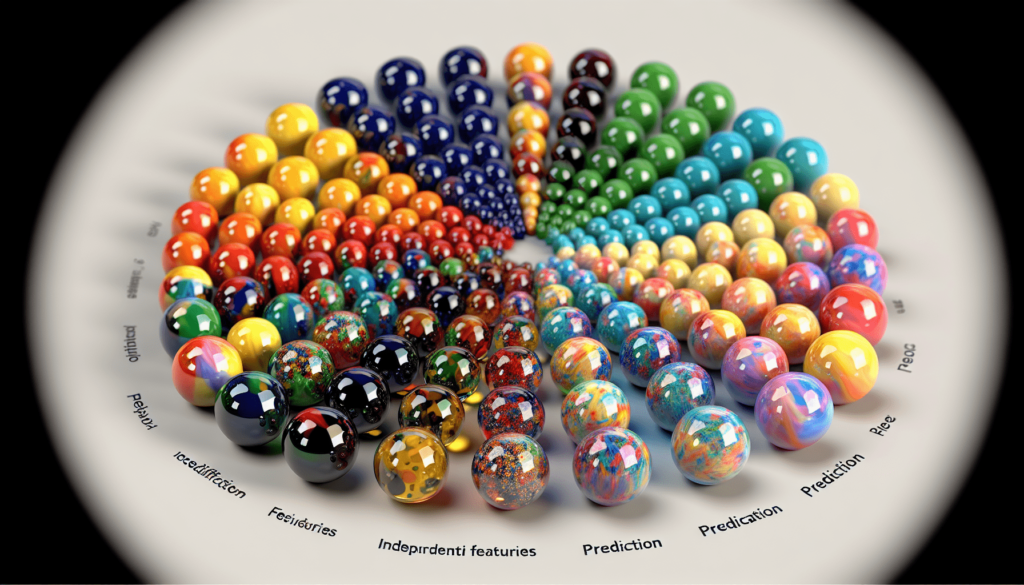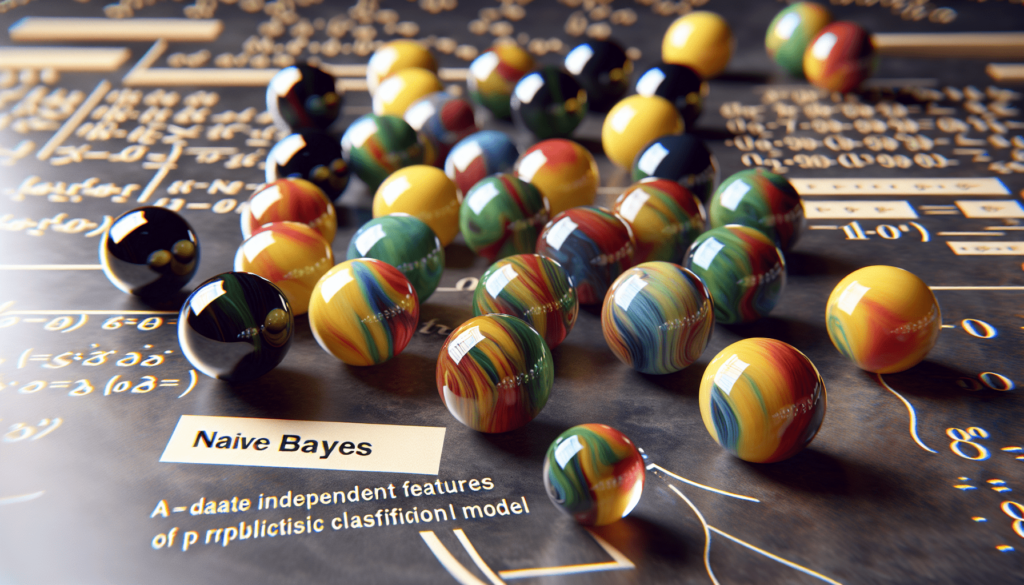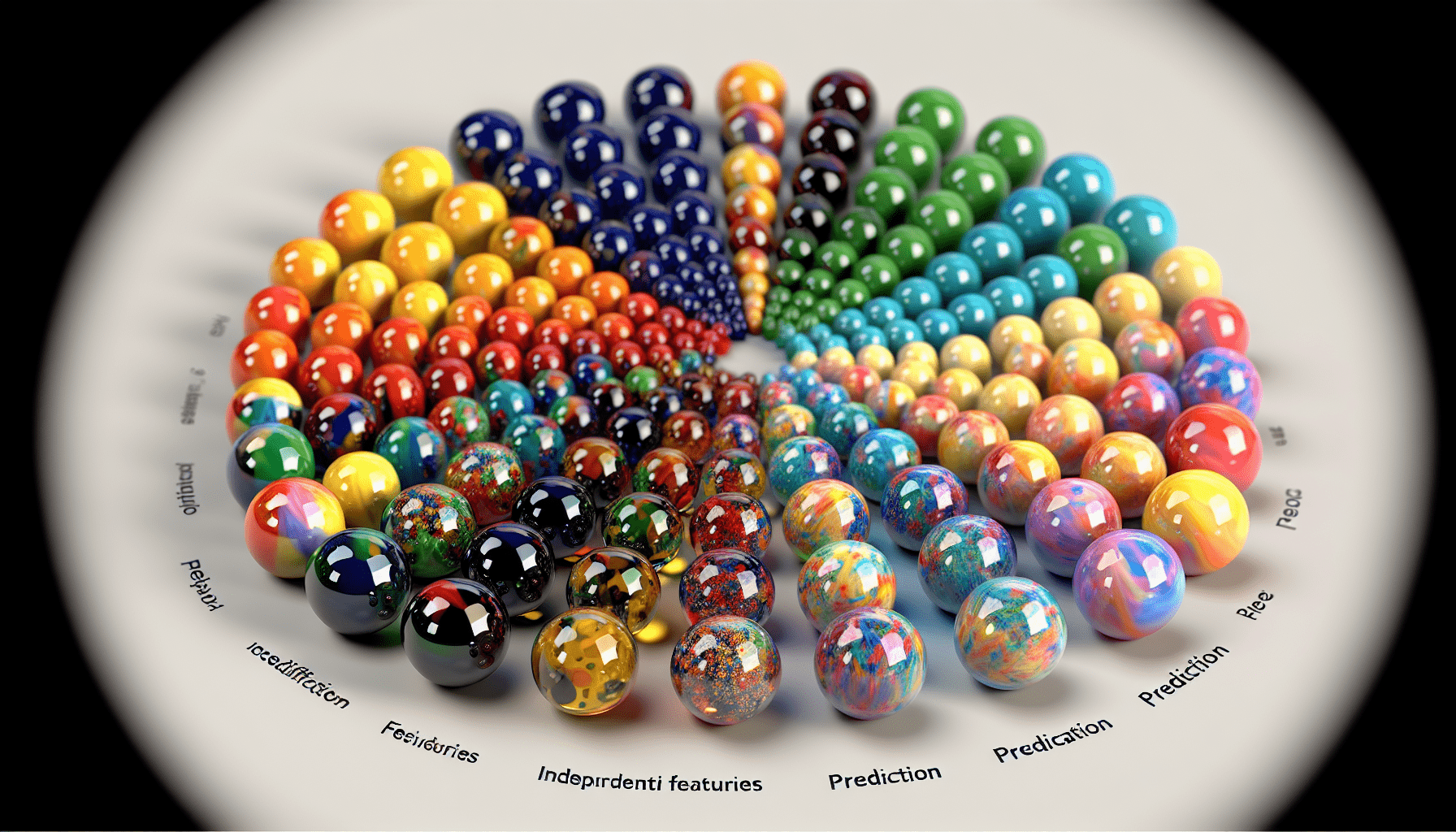Hey there! Have you ever wondered about the concept of Naive Bayes? Well, get ready to explore this fascinating idea! Naive Bayes is a simple yet powerful algorithm used in machine learning and natural language processing. It’s based on Bayes’ theorem and is often used for classifying and categorizing data. In this article, we’ll take a closer look at the fundamentals of Naive Bayes and why it’s such an effective tool in various fields. So, let’s dive right in and discover the ins and outs of Naive Bayes together!
Definition of Naive Bayes
Overview of Naive Bayes
Naive Bayes is a machine learning algorithm used for classification tasks. It is based on Bayesian probability theory and is known for its simplicity and efficiency. Naive Bayes assumes that the features in a dataset are independent of each other, which is often an oversimplification but allows for fast computation. Despite this assumption, Naive Bayes has proven to be effective in a wide range of applications, including text classification, spam filtering, medical diagnosis, credit scoring, and recommendation systems.
Mathematical Basis of Naive Bayes
Naive Bayes is based on Bayes’ theorem, which provides a way to calculate the probability of a hypothesis given some evidence. The theorem states that the posterior probability of a hypothesis is proportional to the prior probability of the hypothesis multiplied by the likelihood of the evidence given the hypothesis. In the case of Naive Bayes, the hypothesis corresponds to a particular class label, and the evidence corresponds to the features of an instance. The algorithm calculates the posterior probability of each class label and assigns the instance to the class with the highest probability.
Assumptions in Naive Bayes
One of the key assumptions in Naive Bayes is that the features in a dataset are independent of each other. This assumption simplifies the calculation of probabilities and allows for efficient computation. However, in many real-world scenarios, this assumption does not hold true, and the features may be dependent on each other. Despite this limitation, Naive Bayes has been shown to be effective in practice, partly due to its ability to handle large feature spaces and its robustness to irrelevant features.
History of Naive Bayes
Origins of Naive Bayes
The origins of Naive Bayes can be traced back to the work of Reverend Thomas Bayes in the 18th century. Bayes’ theorem, which forms the foundation of Naive Bayes, was developed by Bayes and later published posthumously. However, it was not until the 20th century that Naive Bayes gained popularity in the field of machine learning.
Development and Evolution of Naive Bayes
Over the years, Naive Bayes has undergone various developments and evolutions. One significant breakthrough was the introduction of the Naive Bayes classifier by E.T. Jaynes in the 1950s. Jaynes proposed the use of the Naive Bayes algorithm for pattern recognition tasks and demonstrated its effectiveness in several applications. Since then, Naive Bayes has become a staple algorithm in the field of machine learning, with various extensions and modifications being introduced to improve its performance in different domains.

Applications of Naive Bayes
Text Classification
One of the most common applications of Naive Bayes is in text classification tasks. It can be used to automatically categorize documents into different classes, such as spam or non-spam emails, topic classification of news articles, sentiment analysis of social media posts, and many more. Naive Bayes takes advantage of the features in the text, such as the frequency of words or the presence of certain keywords, to make predictions about the class label of a document.
Spam Filtering
Naive Bayes is widely used in spam filtering systems to distinguish between legitimate emails and spam messages. By analyzing the content and characteristics of incoming emails, Naive Bayes can determine the probability of a given email being spam or non-spam. This information is then used to filter out unwanted messages and ensure that they do not reach the user’s inbox. Naive Bayes’ ability to handle large feature spaces and its simplicity make it an effective choice for this task.
Medical Diagnosis
Naive Bayes has found applications in medical diagnosis, where it can be used to predict the likelihood of a patient having a particular disease based on various symptoms and medical tests. By training the Naive Bayes classifier on a dataset of known cases, the algorithm can learn the relationships between the symptoms and the diseases. This knowledge can then be used to make predictions on new, unseen cases and assist healthcare professionals in making accurate diagnoses.
Credit Scoring
In the financial industry, Naive Bayes is used for credit scoring, which involves assessing the creditworthiness of individuals or businesses. By analyzing various factors such as income, credit history, and employment status, Naive Bayes can predict the probability of a borrower defaulting on a loan or credit card payment. This information is invaluable to lenders and financial institutions in determining the risk associated with extending credit to a particular applicant.
Recommendation Systems
Naive Bayes is also utilized in recommendation systems, which are used to provide personalized recommendations to users based on their preferences and past behavior. By analyzing the features of items and the historical data of user interactions, Naive Bayes can predict the likelihood of a user being interested in a particular item. This information is then used to generate recommendations that are aligned with the user’s preferences, enhancing their overall experience.
Strengths of Naive Bayes
Simplicity and Efficiency
One of the key strengths of Naive Bayes is its simplicity and efficiency. The algorithm is easy to understand and implement, making it suitable for both novice and experienced machine learning practitioners. Naive Bayes is computationally efficient because it requires minimal computation compared to other algorithms, making it a practical choice for large datasets and real-time applications.
Ability to Handle Large Feature Spaces
Naive Bayes can effectively handle large feature spaces, which is particularly advantageous in text classification tasks where the number of words or features can be vast. Its ability to deal with high-dimensional data allows it to capture the subtle patterns and relationships between features, leading to accurate predictions. Moreover, Naive Bayes can handle both continuous and categorical features, making it flexible in handling a wide range of data types.
Robustness to Irrelevant Features
Naive Bayes is relatively robust to irrelevant features, meaning that it can still make accurate predictions even when some features in the dataset are not informative or carry little predictive power. This robustness is beneficial in scenarios where the presence of irrelevant features cannot be avoided or easily eliminated. Naive Bayes is capable of weighting the informative features more heavily, effectively ignoring the irrelevant ones.
Strong Performance with Categorical Data
Naive Bayes performs particularly well with categorical data, where the features are discrete and have a finite number of possible values. This strengths can be attributed to the assumption of feature independence, which simplifies the computations and reduces the complexity associated with categorical data. As a result, Naive Bayes can effectively model the relationships between the features and the class labels, leading to accurate predictions.

Limitations of Naive Bayes
Assumption of Feature Independence
One of the limitations of Naive Bayes is its assumption of feature independence. This assumption does not hold true in many real-world scenarios, as features are often interdependent and exhibit complex relationships. This oversimplification can affect the accuracy of the predictions and lead to suboptimal performance, especially when the dependencies between features are significant. However, in practice, Naive Bayes has been shown to perform reasonably well, despite this limitation.
Sensitive to Input Data Quality
Naive Bayes is sensitive to the quality of the input data, particularly when dealing with noisy or missing values. The algorithm assumes that the input data adheres to a certain distribution, such as a normal distribution for continuous features. If the data deviates significantly from these assumptions, the accuracy of the predictions can be compromised. Therefore, it is crucial to preprocess the data and address any issues related to data quality before applying Naive Bayes.
Unreliable Probability Estimates
Naive Bayes tends to produce unreliable probability estimates, meaning that the predicted probabilities may not accurately reflect the true probabilities. This is due to the zero count problem, where a particular feature value may not occur in the training data, leading to a probability estimate of zero and causing the entire prediction to be incorrect. To alleviate this issue, techniques such as Laplace smoothing can be used to assign a small probability to unseen feature values.
Impact of Class Imbalance
Naive Bayes can be sensitive to class imbalance, where one class has significantly more instances than the other(s). In such cases, the algorithm tends to favor the majority class and may struggle to accurately predict the minority class. This can be problematic in applications where the minority class is of particular interest, such as fraud detection or rare disease diagnosis. Techniques like oversampling or undersampling can be employed to address this issue and balance the class distribution.
Types of Naive Bayes Classifiers
Gaussian Naive Bayes
Gaussian Naive Bayes assumes that the features follow a Gaussian distribution. This classifier is suitable for continuous features and canmodel the likelihood of each class as a Gaussian distribution with a mean and variance. The probability of a new instance belonging to a particular class is then calculated based on its feature values using the Gaussian distribution parameters of that class.
Multinomial Naive Bayes
Multinomial Naive Bayes is designed for discrete features, particularly when the features represent counts or frequencies. It models the likelihood of each class as a multinomial distribution over the feature values. In text classification tasks, for example, the features can be the frequency of words, and the classifier calculates the probability of a document belonging to a particular class based on the word frequencies.
Bernoulli Naive Bayes
Bernoulli Naive Bayes is similar to Multinomial Naive Bayes, but it is specifically designed for binary features where each feature can only take two possible values, typically 0 and 1. It models the likelihood of each class as a Bernoulli distribution and calculates the probability of a new instance belonging to a particular class based on its binary feature values. This classifier is commonly used in spam filtering tasks, where the features represent the presence or absence of certain words.
Training and Testing with Naive Bayes
Data Preprocessing
Before applying Naive Bayes to a dataset, it is essential to preprocess the data. This includes steps such as removing irrelevant features, handling missing values, and handling categorical features. Irrelevant features can be identified by analyzing their correlation with the class labels or by domain knowledge. Missing values can be imputed using techniques such as mean or median imputation. Categorical features can be encoded using one-hot encoding or label encoding, depending on the nature of the features.
Feature Extraction
Feature extraction is a crucial step in preparing the data for Naive Bayes. It involves transforming the raw input data into a suitable representation that captures the relevant information. In the case of text classification, for example, feature extraction can involve techniques such as bag-of-words or TF-IDF (Term Frequency-Inverse Document Frequency) encoding, which represent the documents as vectors of word frequencies or weighted word frequencies.
Model Training
Once the data is preprocessed and the features are extracted, the next step is to train the Naive Bayes model on the training data. During training, the algorithm estimates the parameters of the probability distributions for each feature and class. For Gaussian Naive Bayes, this involves calculating the mean and variance for each feature and class. For Multinomial Naive Bayes, this involves calculating the probabilities of each feature value for each class. For Bernoulli Naive Bayes, this involves calculating the probabilities of each feature being 1 or 0 for each class.
Model Testing
After the model is trained, it can be evaluated on a separate testing dataset to assess its performance. The testing dataset should be representative of the real-world data that the model will encounter. The model predicts the class labels for the instances in the testing dataset using the learned parameters. The predictions are then compared to the true class labels to calculate various performance metrics, such as accuracy, precision, recall, and ROC curves.
Comparison with Other Machine Learning Algorithms
Naive Bayes vs Logistic Regression
Naive Bayes and logistic regression are both popular machine learning algorithms for classification tasks, but they differ in their underlying assumptions and modeling approaches. Naive Bayes assumes the independence of features, while logistic regression makes no such assumption. Logistic regression estimates the parameters of a sigmoid function to model the relationship between the features and the class probabilities, while Naive Bayes calculates the probabilities directly using the probability distributions. The choice between Naive Bayes and logistic regression depends on the specific characteristics of the dataset and the modeling objectives.
Naive Bayes vs Decision Trees
Decision trees and Naive Bayes are both versatile machine learning algorithms that can be used for classification tasks. Decision trees create a flowchart-like structure that partitions the feature space based on the feature values, while Naive Bayes calculates the probabilities directly using the probability distributions. Decision trees are typically more interpretable and can capture complex interactions between features, but they can be prone to overfitting. Naive Bayes, on the other hand, is computationally efficient and robust to irrelevant features but makes the assumption of feature independence.
Naive Bayes vs Support Vector Machines
Naive Bayes and support vector machines (SVM) are commonly used algorithms for classification tasks. SVM aims to find the optimal hyperplane that separates the data points of different classes with the maximum margin, while Naive Bayes calculates the probabilities directly using the probability distributions. SVM can handle complex decision boundaries and is effective in high-dimensional spaces, but it can be computationally expensive. Naive Bayes, on the other hand, is computationally efficient and suitable for large feature spaces, but it assumes feature independence.
Evaluating the Performance of Naive Bayes
Accuracy
Accuracy is a common performance metric used to evaluate the performance of Naive Bayes and other machine learning algorithms. It measures the proportion of correctly predicted instances out of the total number of instances. While accuracy provides a general measure of overall performance, it may not be suitable for imbalanced datasets where the class distribution is skewed. In such cases, other metrics such as precision, recall, and F1 score should be considered.
Precision and Recall
Precision and recall are performance metrics that provide insights into the quality of the predictions made by a Naive Bayes classifier. Precision measures the proportion of correctly predicted positive instances out of the total number of instances predicted as positive. Recall, on the other hand, measures the proportion of correctly predicted positive instances out of the total number of true positive instances in the dataset. The precision-recall trade-off can be adjusted by changing the classification threshold.
ROC Curves
ROC (Receiver Operating Characteristic) curves are used to evaluate the performance of Naive Bayes and other classifiers across different classification thresholds. ROC curves plot the true positive rate (sensitivity) against the false positive rate (1 – specificity) as the classification threshold is varied. The area under the ROC curve (AUC) is often used as a summary metric of the classifier’s performance. A higher AUC indicates better performance in distinguishing between the classes.
Cross-Validation
Cross-validation is a technique used to estimate the performance of a Naive Bayes classifier on unseen data. It involves splitting the dataset into multiple subsets or “folds” and training the model on a subset while testing it on the remaining subset. This process is repeated multiple times, with different subsets used for training and testing. Cross-validation provides a more reliable estimate of the model’s performance compared to a simple train-test split, as it accounts for the variability in the data and reduces the risk of overfitting.
Conclusion
Naive Bayes is a versatile and widely used machine learning algorithm that has proven to be effective in a variety of applications. Its simplicity and efficiency make it a practical choice for large datasets and real-time applications. While Naive Bayes makes the assumption of feature independence and can be sensitive to input data quality, it has strengths in handling large feature spaces, robustness to irrelevant features, and strong performance with categorical data. By understanding the strengths and limitations of Naive Bayes, practitioners can make informed decisions on when and how to use this algorithm in their machine learning projects.
